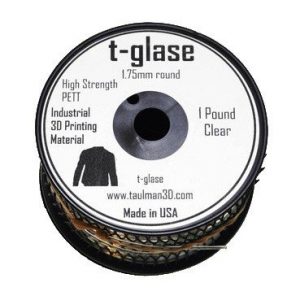Printing with Transparent Filaments: How to Get the Best Results and the Best Brands Available
So far, we have written several articles which highlight the aesthetic possibilities of 3D printing. Whether you are going for a print with a metallic finish, or something that looks like it was carved out of wood or stone, the 3D printing industry has evolved quickly enough to keep up with the demands of user creativity. However, one of the more common questions we hear from users is whether it is possible to make 3D prints that are truly transparent or have a glass-like finish. Worry no more, as we have scoured the 3D printing market for the best transparent filaments.
What are transparent filaments?
Unlike other specialty filaments, there is really no clear answer to this question. Different brands of transparent filaments from different manufacturers are usually made from different materials, although a cursory look will reveal that most of them are made from PETT or PETG.
Although some transparent filaments are branded as “glass” filaments, not all of them are filaments infused with actual glass. Real glass is a very brittle and abrasive material, and the optical properties of glass probably does not easily translate well to a glass-infused plastic filament. But who knows? Perhaps a true glass filament can be developed in the near future.
What are the best brands of transparent filaments?
Although transparent 3D printings are a very interesting project, we find that the market is still quite limited in terms of transparent filament products. We highlighted below the most popular brands available, along with a few details about each one.

The Taulman Clear T-Glase was one of the earlier entries into the transparent filament game and remains one of the most popular options. T-Glase is made from the highest optical quality PETT, which combines good transparency and above average toughness. An added bonus to the T-Glase filament is the fact that it uses an FDA-approved material so you can feel free to use it to make direct food or drink containers. On top of all these advantages, T-Glase does not produce noxious fumes during printing.
The HDGlass filament from FormFutura constitutes a series of transparent filaments available in several variants such as clear, black, and fluorescent. This filament line made waves upon its release as FormFutura claimed that it was a filament designed with maximum transparency in mind. The HDGlass filament is made from FDA-approved PETG, so you can safely use it for prints that will come in direct contact with food.
The HD in HDGlass stands for ‘heavy duty’. True to its moniker, the HDGlass filament claims to be very tough with excellent temperature resistance. FormFutura has made the bold claim that their HDGlass filament comes closest to real glass compared to any other glass or transparent filament product out in the market. As you will see later, making truly transparent prints is not as easy as it sounds.
The ZGLASS transparent filament from Zortrax stands in a league of its own for being the only popular filament brand out in the market that infuses real glass fibers into a plastic filament. Curiously, it is only a mildly popular brand despite its unique qualifications. Similar to the other filaments mentioned, the ZGLASS filament boasts of superior toughness and temperature resistance on top of having excellent optical properties. The ZGLASS filament was engineered to be used with the Zortrax M200 3D printer.
How do you make transparent prints?
Now that you have your fancy glass filament, what are you going to do with it? As we have hinted earlier, making a truly transparent print will not exactly be a walk in the park. The matter is further complicated by the fact that ‘glass’ filaments are made from different materials, so there is no single rule that will apply to all.
The T-Glase filament has been advertised to work best with settings similar to those of PLA. This implies printing with relatively low temperatures. However, most users have reported that the transparency of the final print is actually better when printed at temperatures of around 240 °C. T-Glase adheres very easily to the printing bed, but you may use standard PVA glue just to be sure. We also recommend using a heated printing bed at 80 °C setting.
A few other factors also come in play when trying to make transparent prints using T-Glase. You will want to tweak your settings to allow for the longest uninterrupted optical path. A good start in achieving this is by increasing the layer height from the standard settings, up to about 80% of the nozzle setting. How thick should your layer height be? Most users have reported good results when using at least 70% to up to 90% of their nozzle setting. Since you will want to produce thicker layers, it will also help to use bigger nozzles.
The advice to use bigger nozzles and set higher layer heights means that you will have to heat up and extrude a higher than average amount of filament throughout the printing process. This means that the printing speed will have to be significantly lowered to accommodate this requirement. We recommend that you start at 25% of the maximum printing speed and play around to gradually increase the settings. Nevertheless, we do not recommend going above 30% printing speed. Most users also do not recommend the use of a cooling fan when printing with transparent filaments.
Even with optimal settings, attempting to make transparent prints come with a few limitations. The recommendation to increase the layer height settings means that you will lose a lot of vertical resolution, so highly details designs may not be done justice. Ensuring a long optical path also means that you will have to make do with prints with very little infill. This reduces the toughness of the final print significantly. Fortunately, PETG and PETT are quite sturdy even in thin layers.
A word of caution
Most transparent filaments are advertised as being FDA-approved and food safe since they are made from PET-derived materials. However, keep in mind that the filament comes into contact with the metal of the extruder during printing, and this metal may transmit compounds into the final print which will render them not safe for food contact. Your extruder likely also has come into contact with other filament materials that are more toxic, such as ABS, so cross-contamination is quite likely.
By the very concept of FDM printing, 3D prints are filled with microscopic nooks and crannies which may be breeding grounds for bacteria. Before using a 3D print for food applications, you may have to consider a post-printing treatment such as polishing or application of a food-safe coating to ensure a completely smooth finish.
Conclusions
So-called ‘glass’ filaments are not necessarily made with any glass but are so called because of the transparent prints that can be made from them. Making transparent prints is not exactly easy and you will probably have to make several trials to get satisfying results but sticking to the concepts of optics should help you get there eventually.
On the other hand, PETG or PETT are materials that are easy to handle, with good layer adhesion and excellent toughness and temperature resistance. Even if you fail in making truly transparent prints, you will still end up with a print that is both sturdy and visually striking. If you do come up with printer settings that fully utilize the optical potential of glass filaments, then do not hesitate to drop a comment below.





